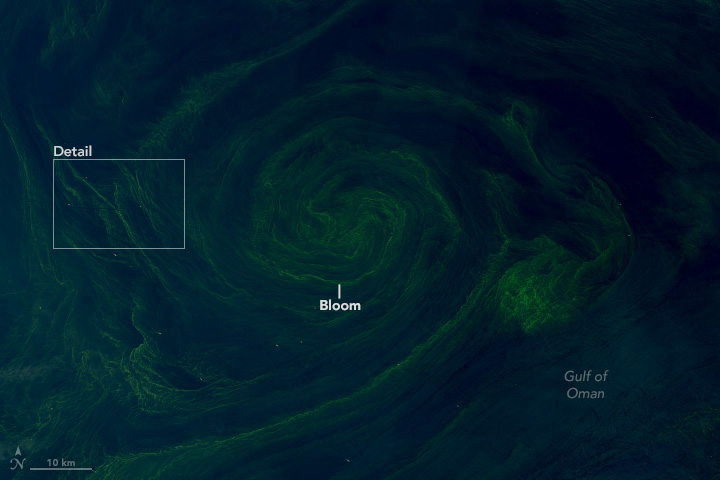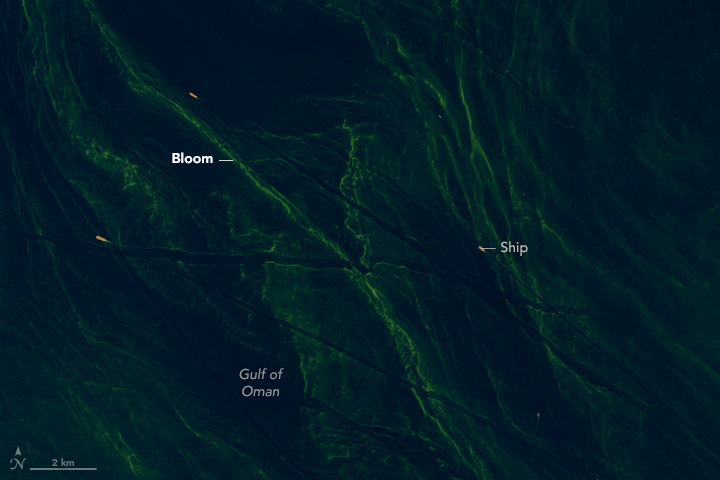
A Swirl of a Day for Phytoplankton
Downloads
- omanbloom_oli_20250308_lrg.jpg (3833x2555, JPEG)
- omanbloom_oli_20250308_lrg.jpg (3833x2555, JPEG)
Metadata
- Sensor(s):
- Landsat 8 - OLI
- Data Date: March 8, 2025
- Visualization Date: March 25, 2025
The Gulf of Oman is a funnel-shaped body of water between Oman and Iran that connects to the Strait of Hormuz and Persian Gulf to the east and the Arabian Sea to the west. It is a busy hub of international shipping and also supports extensive artisanal fisheries that are important to the economies of several countries in the region.
One notable aspect of the gulf is its frequent blooms of phytoplankton—sharp increases in the population of microscopic plant-like organisms at the base of the aquatic food web. Blooms often occur in a seasonal rhythm when environmental conditions are most conducive to phytoplankton reproduction.
The largest blooms in this region typically occur in the winter and early spring (January through March) and the summer (June through August), when water temperatures, light conditions, and nutrient availability are favorable. Monsoon winds are a key driver of winter and early spring blooms because they push surface waters away from the coast and cause an upwelling of cool, nutrient-rich water.
Blooming phytoplankton can produce quite a show when viewed from above, sometimes becoming large enough to be visible from space. For much of February and March, multiple NASA satellites observed a bloom that drifted across the Gulf of Oman and into the Arabian Sea.
Eddies and currents drew phytoplankton into narrow swirling bands on March 8, 2025, when the OLI (Operational Land Imager) on Landsat 8 captured the images above. The OCI (Ocean Color Instrument) on the PACE (Plankton, Aerosol, Cloud, Ocean Ecosystem) satellite acquired similar images on March 8 and March 24, along with measurements of the concentration of chlorophyll in surface waters.
Like plants on land, phytoplankton use chlorophyll and other light-harvesting pigments to carry out photosynthesis, absorbing carbon dioxide to produce sugars for fuel. Chlorophyll in the water changes the way it reflects and absorbs sunlight, allowing scientists to map the amount and location of phytoplankton.
The swirls of green likely include Noctiluca scintillans—a type of marine dinoflagellate that has been found here in the past. Though Noctiluca blooms can be beautiful, their presence can have serious consequences for ocean life. Bacteria consume oxygen as they break down the dead phytoplankton, which can cause hypoxia, sometimes depleting oxygen levels enough to kill fish and other marine life.
Across the wider Arabian Sea, waters have transitioned in recent decades from supporting abundant diatoms—a type of phytoplankton important for the marine food web—to being dominated by Noctiluca. Unlike diatoms, Noctiluca can thrive in waters that are more stratified and contain fewer dissolved nutrients. This shift has had ripple effects, including an increase in jellyfish and salps, and a decline in copepods and finfish.
References
- Ben-Hasan, A., & Daliri, M. (2023) Arabian/Persian Gulf artisanal fisheries: magnitude, threats, and opportunities. Reviews in Fish Biology and Fisheries, 33, 541-559.
- Cetinić, I., et al. (2024) Phytoplankton composition from sPACE: Requirements, opportunities, and challenges. Remote Sensing of Environment, 302, 113964.
- Goes, J., et al. (2020) Ecosystem state change in the Arabian Sea fueled by the recent loss of snow over the Himalayan-Tibetan Plateau region. Scientific Reports, 10, 7422.
- Khan, M., et al. (2024) Two-decade variability and trend of chlorophyll-a in the Arabian Sea and Persian Gulf based on reconstructed satellite data. Frontiers in Marine Science, 11, 1520775.
- Lakshmi, R., et al. (2025) An in-depth analysis of the impact of environmental drivers on the variability of phytoplankton community in the Arabian Sea during 2010-2021. Environmental Science: Processes & Impacts, 27(4), 1234-1249.
- NASA Earth Observatory (2021, August 4) An Upended Ecosystem in the Arabian Sea. Accessed March 25, 2025.
- NASA Earth Observatory (2024, May 8) Complex Beauty in the Gulf of Oman. Accessed March 25, 2025.
- Shi, W., & Wang, M. (2022) Phytoplankton biomass dynamics in the Arabian Sea from VIIRS observations. Journal of Marine Systems, 227, 103670.
- Thoppil, P., et al. (2023) Enhanced phytoplankton bloom triggered by atmospheric high-pressure systems over the Northern Arabian Sea. Scientific Reports, 13, 27785.
NASA Earth Observatory images by Wanmei Liang, using Landsat data from the U.S. Geological Survey. Story by Adam Voiland.
This image record originally appeared on the Earth Observatory. Click here to view the full, original record.
